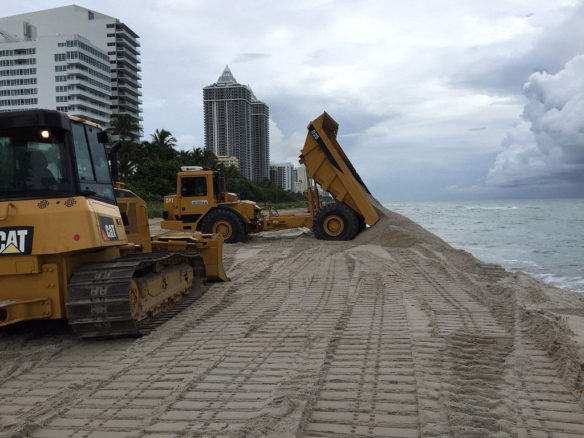
Miami beach renourishment, Florida, 8-30-2016. Photo source: ©© Jaxstrong
“Development is absolutely responsible for the majority of the beach nourishment,” Andrew Coburn, assistant director of The Program for the Study of Developed Shorelines at Western Carolina University, said. “Well over 99 percent of the shorelines that are nourished are developed so there is some economic value placed behind them.”
Excerpts;
Miami Beach has run out of sand. Now what?
Read Full Article, The Verge (11-17-2016)
Increased flooding, accelerated sea-level rise in Miami over last decade, new study shows; Science Daily (04-05-2016)
Miami Beach flood events have significantly increased over the last decade due to an acceleration of sea-level rise in South Florida, a new report warns. The researchers suggest that regional sea-level projections should be used in place of global projections to better prepare for future flood hazards in the region…
Miami Beach Sees Rising Seas as No Threat to Real Estate Boom, For Now, Phys.Org (04-22-2015)
Water world: rising tides close in on Trump, the climate change denier; Guardian UK (07-07-2016)
Climate change has barely registered as a 2016 campaign issue, but in Florida, the state which usually decides the presidential election, the waters are lapping at the doors of Donald Trump’s real estate empire…
Rising Seas Threaten South Florida’s Drinking Water, Market Place (02-16-2015)
Greater Miami is a place where the idea of not having enough water seems completely inconceivable. South Florida receives about 60 inches of rainfall a year, and groundwater is more than plentiful. But rising sea levels change things in unexpected ways, and seawater threatens to turn the drinking water salty…
Shrinking Shores: Florida sand shortage leaves beaches in lurch, The Naples Daily News (11-17-2016)
Beaches are built one truckload at a time as the main ingredient in the State’s beach renourishemnt program – offshore sand – gets harder to find…
The Beach Boondoggle; Op Ed by Robert Young, The New York Times (10-12-2016)
Coastal geologist criticizes beach renourishment efforts; By Robert S. Young, PhD; The State (08-17-2016)
Rob Young, who heads the Program for the Study of Developed Shorelines at Western Carolina University, said the government is subsidizing coastal development with renourishment money – and that’s costing taxpayers. Communities across the country have spent millions of dollars renourishing beaches. Those efforts encourage people to rebuild after every major hurricane…
Palm Beach Mid-Town Dredge Project, A Youtube Video (02-04-2015)
“Beach nourishment projects like this have become commonplace along the US East and Gulf Coasts. These projects have immediate environmental impacts through burial of nearshore habitat and increased turbidity during project placement.The cumulative environmental impacts of doing this repeatedly on the same beach while conducting projects from Maine to Texas is unknown. But, we should be concerned. ” —Robert S. Young, PhD, Director, Program for the Study of Developed Shorelines, Professor, Coastal Geology, Western Carolina University
Is Beach Renourishment Worth The Money? WWAY News (02-16-2015)
Beach replenishment may have far reaching impacts on ecosystems;” Phys.Org (03-29-2016)
UC San Diego biologists who examined the biological impact of replenishing eroded beaches with offshore sand found that such beach replenishment efforts could have long-term negative impacts on coastal ecosystems…
Economy Winner, Environment Loser in Renourishment; Pensacola News Journal (12-02-2015)
Piling sand to stop erosion ultimately made the land sink, study says, NOLA (12-26-2015)
Editorial: Beach Replenishment is No Cure-All, Asburry Park Press (05-14-2015)
The Conservation Crisis No One Is Talking About, TakePart (09-21-2016)
Beaches around the world are disappearing. No, the cause isn’t sea-level rise, at least not this time. It’s a little-known but enormous industry called sand mining, which every year sucks up billions of tons of sand from beaches, ocean floors, and rivers to make everything from concrete to microchips to toothpaste…
Coastal erosion needs our attention, South Coast Today (01-04-2016)
Living shorelines a more natural approach to preventing coastal erosion; (05-18-2016)
For centuries, large bulkheads have been used to help control erosion along coastlines. More recent research suggests that a natural approach may be a better alternative. Having nature on your side, especially during a storm or hurricane, is proven to provide better protection from coastal erosion…
Rethinking Living Shorelines, By Orrin H. Pilkey, Rob Young, Norma Longo, and Andy Coburn;Program for the Study of Developed Shorelines / Western Carolina University, March 1, 2012, Nicholas School of the Environment, Duke University
In response to the detrimental environmental impacts caused by traditional erosion control structures, environmental groups, state and federal resource management agencies, now advocate an approach known as “Living Shorelines”that embraces the use of natural habitat elements such as indigenous vegetation, to stabilize and protect eroding shorelines.
Sand, Rarer Than One Thinks: A UNEP report (GEA-March 2014)
Despite the colossal quantities of sand and gravel being used, our increasing dependence on them and the significant impact that their extraction has on the environment, this issue has been mostly ignored by policy makers and remains largely unknown by the general public.
In March 2014 The United Nations released its first Report about sand mining. “Sand Wars” film documentary by Denis Delestrac – first broadcasted on the european Arte Channel, May 28th, 2013, where it became the highest rated documentary for 2013 – expressly inspired the United Nations Environment Programme (UNEP) to publish this 2014-Global Environmental Alert.
Sand Wars, An Investigation Documentary, By Award-Winning Filmmaker Denis Delestrac (©-2013)









